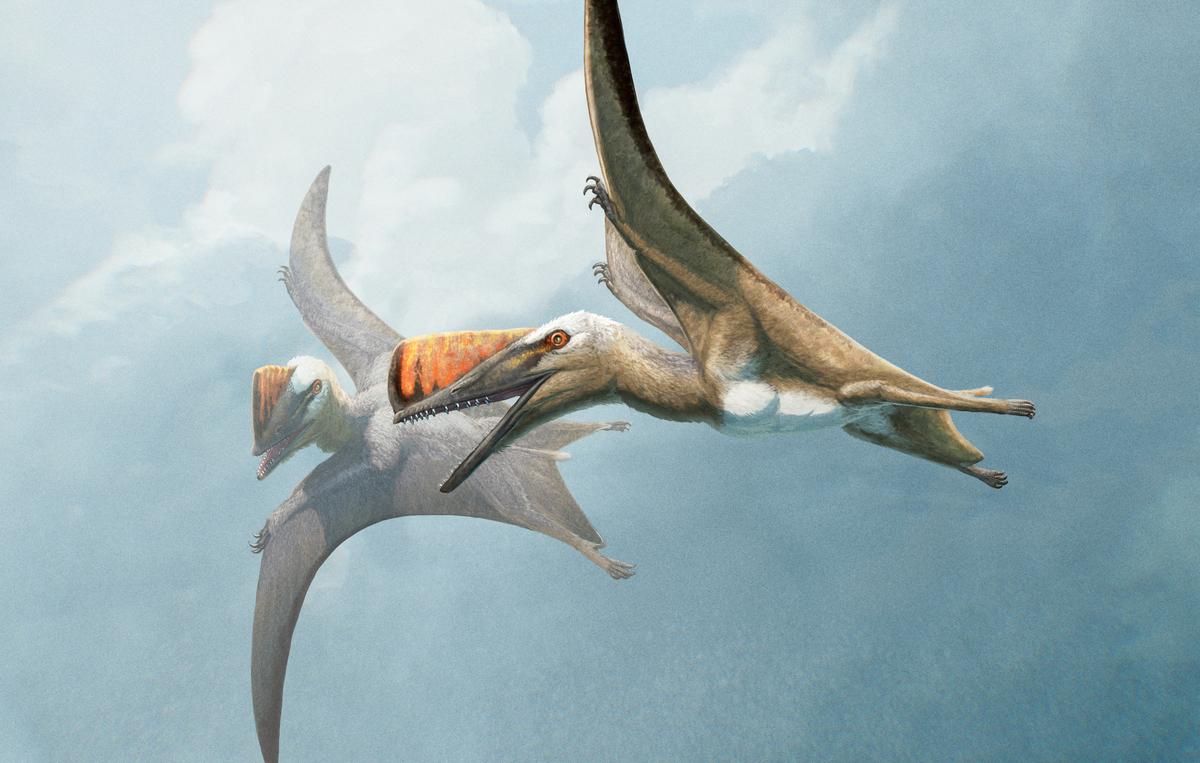
Two pterosaurs of Skiphosoura bavarica, are seen in this image released on Nov. 18.
17:38 JST, November 28, 2024
Aloft over the landscape of Bavaria some 147 million years ago was a pterosaur — an ancient flying reptile — with a wing span of about 2 meters, a bony crest on front of its snout and a mouthful of sharp teeth, searching for a lizard or another nice morsel to eat.
Scientists have unearthed a well-preserved fossil skeleton of this newly identified species, named Skiphosoura bavarica, in a discovery that fills a major gap in the understanding of the evolution of pterosaurs — creatures that were important components of ecosystems during the age of dinosaurs.
Skiphosoura lived toward the end of the Jurassic Period. It is anatomically transitional between the long-tailed and relatively small pterosaurs that originated roughly 80 million years earlier during the Triassic and the short-tailed ones that later would become the giants of the Cretaceous such as Quetzalcoatlus, whose wingspan rivaled that of an F-16 fighter.
“It’s of huge importance,” paleontologist David Hone of Queen Mary University of London, lead author of the study published on Nov. 18 in the journal Current Biology, said of how Skiphosoura provides insight into pterosaur evolution.
“It also brings other pterosaur finds we had already made into focus, better explaining where they go in the family tree of pterosaurs and allowing us to show this transition from the early to late forms — and see what features were changing in what order,” Hone said.
The creature, whose scientific name means “sword tail from Bavaria,” had a short and stiff pointed tail. The specimen has almost every bone in the skeleton preserved in three dimensions, rather than crushed flat like many fossils. It was unearthed in 2015 in the southeastern German state of Bavaria.
“Pterosaur skeletons are really fragile as their bones are so thin, so they often fall apart or are crushed when they are preserved,” Hone said.
Skiphosoura would have been one of the largest fliers in its ecosystem. Its skull was about 25 centimeters long.
“The bony crest is limited to the front of the snout, but it would have had a soft tissue extension on top of this that would have made it quite a bit bigger. It was likely brightly colored or patterned, but we don’t know for sure,” Hone said.
“The teeth are quite long and sharp. They are for puncturing and holding,” Hone said. “It would have been a generalized predator of small prey, taking things like lizards, small mammals, big insects and maybe fish. It was probably living inland, perhaps in forests.”
Pterosaurs, cousins of the dinosaurs, were the first of three vertebrate groups to achieve powered flight, followed by birds about 150 million years ago and bats around 50 million years ago. Pterosaurs were wiped out 66 million years ago in the mass extinction event that also doomed the dinosaurs after an asteroid struck Earth.
Paleontologists divide pterosaurs into two major groups — the early non-pterodactyloids and the later pterodactyloids. The early group’s members possessed a short head, short neck, long tail, short bone in the wrist of the wing and long fifth toe on the foot. The later ones had a large head, long neck, short tail, long wrist and short fifth toe. The later huge pterosaurs also had no teeth.
The discovery of Skiphosoura and another species called Dearc sgiathanach, which lived roughly 170 million years ago in Scotland, have helped clarify key events in pterosaur evolution. They are part of a transitional group called darwinopterans bridging the early and later pterosaurs.
“Skiphosoura lies within the family tree between darwinopteran pterosaurs and their pterodactyloid descendants,” said paleontologist and study coauthor Adam Fitch of the Field Museum in Chicago.
“For over 150 million years, pterosaurs created, opened and maintained countless ecological roles later filled by living birds and their closest relatives — from hunting oceanic prey on the wing to chasing terrestrial prey on foot,” Fitch said. “Through the happenstance of an asteroid hitting Earth 66 million years ago, pterosaurs were removed from these roles forever.”
"Science & Nature" POPULAR ARTICLE
-

Genome Study Reveals Milestone in History of Cat Domestication
-

Big Leap in Quest to Get to Bottom of Climate Ice Mystery
-

Japan Set to Participate in EU’s R&D Framework, Aims to Boost Cooperation in Tech, Energy
-

Paws on Parade: Nairobi’s Dogs Dazzle at ‘Pawchella’
-

Japan’s H3 Rocket Failed in Latest Launch, Says Official
JN ACCESS RANKING
-

Tokyo Economic Security Forum to Hold Inaugural Meeting Amid Tense Global Environment
-

Keidanren Chairman Yoshinobu Tsutsui Visits Kashiwazaki-Kariwa Nuclear Power Plant; Inspects New Emergency Safety System
-

Imports of Rare Earths from China Facing Delays, May Be Caused by Deterioration of Japan-China Relations
-

University of Tokyo Professor Discusses Japanese Economic Security in Interview Ahead of Forum
-

Japan Pulls out of Vietnam Nuclear Project, Complicating Hanoi’s Power Plans






















